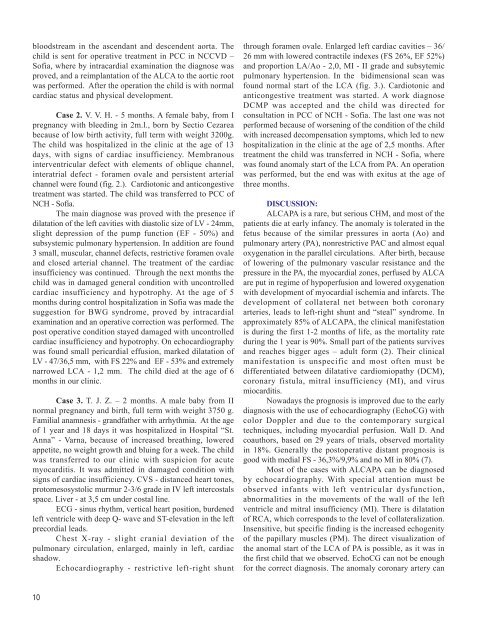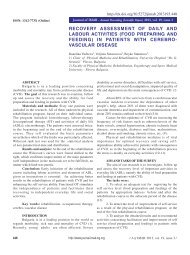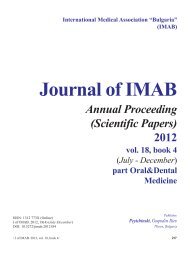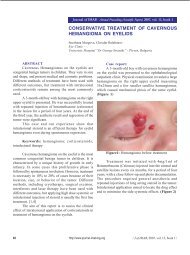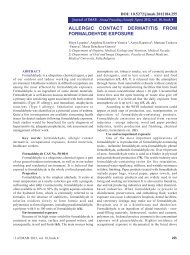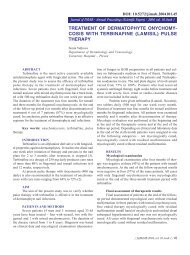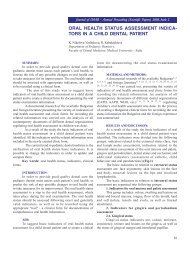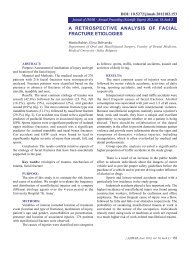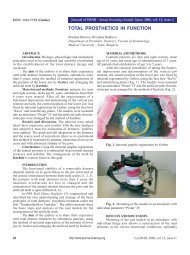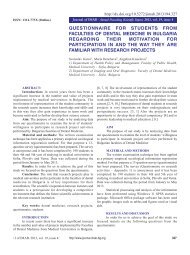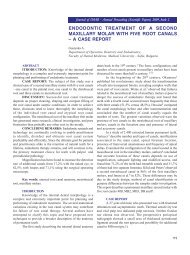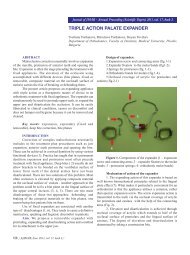Page: 9-12; FULL TEXT - Journal of IMAB
Page: 9-12; FULL TEXT - Journal of IMAB
Page: 9-12; FULL TEXT - Journal of IMAB
Create successful ePaper yourself
Turn your PDF publications into a flip-book with our unique Google optimized e-Paper software.
loodstream in the ascendant and descendent aorta. The<br />
child is sent for operative treatment in PCC in NCCVD –<br />
S<strong>of</strong>ia, where by intracardial examination the diagnose was<br />
proved, and a reimplantation <strong>of</strong> the ALCA to the aortic root<br />
was performed. After the operation the child is with normal<br />
cardiac status and physical development.<br />
Case 2. V. V. H. - 5 months. A female baby, from I<br />
pregnancy with bleeding in 2m.l., born by Sectio Cezarea<br />
because <strong>of</strong> low birth activity, full term with weight 3200g.<br />
The child was hospitalized in the clinic at the age <strong>of</strong> 13<br />
days, with signs <strong>of</strong> cardiac insufficiency. Membranous<br />
interventricular defect with elements <strong>of</strong> oblique channel,<br />
interatrial defect - foramen ovale and persistent arterial<br />
channel were found (fig. 2.). Cardiotonic and anticongestive<br />
treatment was started. The child was transferred to PCC <strong>of</strong><br />
NCH - S<strong>of</strong>ia.<br />
The main diagnose was proved with the presence if<br />
dilatation <strong>of</strong> the left cavities with diastolic size <strong>of</strong> LV - 24mm,<br />
slight depression <strong>of</strong> the pump function (EF - 50%) and<br />
subsystemic pulmonary hypertension. In addition are found<br />
3 small, muscular, channel defects, restrictive foramen ovale<br />
and closed arterial channel. The treatment <strong>of</strong> the cardiac<br />
insufficiency was continued. Through the next months the<br />
child was in damaged general condition with uncontrolled<br />
cardiac insufficiency and hypotrophy. At the age <strong>of</strong> 5<br />
months during control hospitalization in S<strong>of</strong>ia was made the<br />
suggestion for BWG syndrome, proved by intracardial<br />
examination and an operative correction was performed. The<br />
post operative condition stayed damaged with uncontrolled<br />
cardiac insufficiency and hypotrophy. On echocardiography<br />
was found small pericardial effusion, marked dilatation <strong>of</strong><br />
LV - 47/36,5 mm, with FS 22% and EF - 53% and extremely<br />
narrowed LCA - 1,2 mm. The child died at the age <strong>of</strong> 6<br />
months in our clinic.<br />
Case 3. T. J. Z. – 2 months. A male baby from II<br />
normal pregnancy and birth, full term with weight 3750 g.<br />
Familial anamnesis - grandfather with arrhythmia. At the age<br />
<strong>of</strong> 1 year and 18 days it was hospitalized in Hospital “St.<br />
Anna” - Varna, because <strong>of</strong> increased breathing, lowered<br />
appetite, no weight growth and bluing for a week. The child<br />
was transferred to our clinic with suspicion for acute<br />
myocarditis. It was admitted in damaged condition with<br />
signs <strong>of</strong> cardiac insufficiency. CVS - distanced heart tones,<br />
protomesosystolic murmur 2-3/6 grade in IV left intercostals<br />
space. Liver - at 3,5 cm under costal line.<br />
ECG - sinus rhythm, vertical heart position, burdened<br />
left ventricle with deep Q- wave and ST-elevation in the left<br />
precordial leads.<br />
Chest X-ray - slight cranial deviation <strong>of</strong> the<br />
pulmonary circulation, enlarged, mainly in left, cardiac<br />
shadow.<br />
Echocardiography - restrictive left-right shunt<br />
through foramen ovale. Enlarged left cardiac cavities – 36/<br />
26 mm with lowered contractile indexes (FS 26%, EF 52%)<br />
and proportion LA/Ao - 2,0, MI - II grade and subsytemic<br />
pulmonary hypertension. In the bidimensional scan was<br />
found normal start <strong>of</strong> the LCA (fig. 3.). Cardiotonic and<br />
anticongestive treatment was started. A work diagnose<br />
DCMP was accepted and the child was directed for<br />
consultation in PCC <strong>of</strong> NCH - S<strong>of</strong>ia. The last one was not<br />
performed because <strong>of</strong> worsening <strong>of</strong> the condition <strong>of</strong> the child<br />
with increased decompensation symptoms, which led to new<br />
hospitalization in the clinic at the age <strong>of</strong> 2,5 months. After<br />
treatment the child was transferred in NCH - S<strong>of</strong>ia, where<br />
was found anomaly start <strong>of</strong> the LCA from PA. An operation<br />
was performed, but the end was with exitus at the age <strong>of</strong><br />
three months.<br />
DISCUSSION:<br />
ALCAPA is a rare, but serious CHM, and most <strong>of</strong> the<br />
patients die at early infancy. The anomaly is tolerated in the<br />
fetus because <strong>of</strong> the similar pressures in aorta (Ao) and<br />
pulmonary artery (PA), nonrestrictive PAC and almost equal<br />
oxygenation in the parallel circulations. After birth, because<br />
<strong>of</strong> lowering <strong>of</strong> the pulmonary vascular resistance and the<br />
pressure in the PA, the myocardial zones, perfused by ALCA<br />
are put in regime <strong>of</strong> hypoperfusion and lowered oxygenation<br />
with development <strong>of</strong> myocardial ischemia and infarcts. The<br />
development <strong>of</strong> collateral net between both coronary<br />
arteries, leads to left-right shunt and “steal” syndrome. In<br />
approximately 85% <strong>of</strong> ALCAPA, the clinical manifestation<br />
is during the first 1-2 months <strong>of</strong> life, as the mortality rate<br />
during the 1 year is 90%. Small part <strong>of</strong> the patients survives<br />
and reaches bigger ages – adult form (2). Their clinical<br />
manifestation is unspecific and most <strong>of</strong>ten must be<br />
differentiated between dilatative cardiomiopathy (DCM),<br />
coronary fistula, mitral insufficiency (MI), and virus<br />
miocarditis.<br />
Nowadays the prognosis is improved due to the early<br />
diagnosis with the use <strong>of</strong> echocardiography (EchoCG) with<br />
color Doppler and due to the contemporary surgical<br />
techniques, including myocardial perfusion. Wall D. And<br />
coauthors, based on 29 years <strong>of</strong> trials, observed mortality<br />
in 18%. Generally the postoperative distant prognosis is<br />
good with medial FS - 36,3%/9,9% and no MI in 80% (7).<br />
Most <strong>of</strong> the cases with ALCAPA can be diagnosed<br />
by echocardiography. With special attention must be<br />
observed infants with left ventricular dysfunction,<br />
abnormalities in the movements <strong>of</strong> the wall <strong>of</strong> the left<br />
ventricle and mitral insufficiency (MI). There is dilatation<br />
<strong>of</strong> RCA, which corresponds to the level <strong>of</strong> collateralization.<br />
Insensitive, but specific finding is the increased echogenity<br />
<strong>of</strong> the papillary muscles (PM). The direct visualization <strong>of</strong><br />
the anomal start <strong>of</strong> the LCA <strong>of</strong> PA is possible, as it was in<br />
the first child that we observed. EchoCG can not be enough<br />
for the correct diagnosis. The anomaly coronary artery can<br />
10


